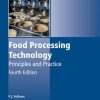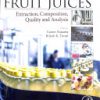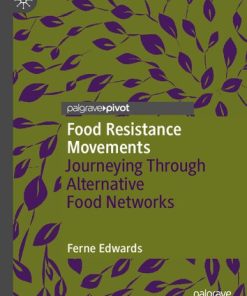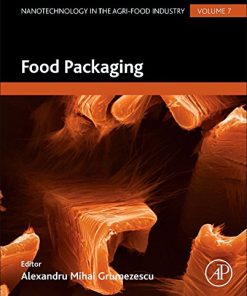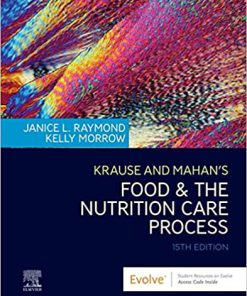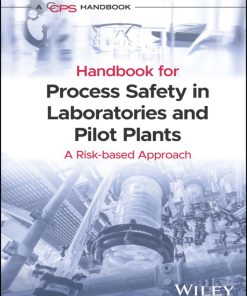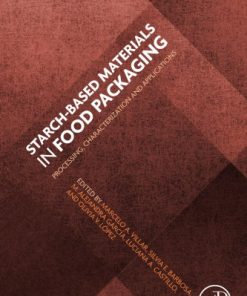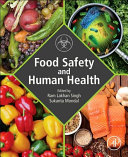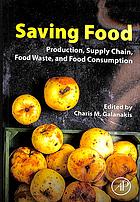Present Knowledge in Food Safety A Risk Based Approach Through the Food Chain 1st edition by Michael Knowles, Lucia Anelich, Alan Boobis, Bert Popping 0128231548 9780128231548
$50.00 Original price was: $50.00.$25.00Current price is: $25.00.
Present Knowledge in Food Safety : A Risk-Based Approach Through the Food Chain 1st edition by Michael E. Knowles, Lucia Anelich, Alan Boobis, Bert Popping – Ebook PDF Instant Download/DeliveryISBN: 0128231548, 9780128231548
Full download Present Knowledge in Food Safety : A Risk-Based Approach Through the Food Chain 1st edition after payment.
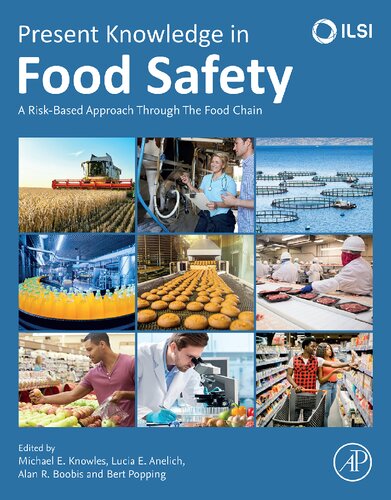
Product details:
ISBN-10 : 0128231548
ISBN-13 : 9780128231548
Author : Michael E. Knowles, Lucia Anelich, Alan Boobis, Bert Popping
Present Knowledge in Food Safety: A Risk-Based Approach Through the Food Chain presents approaches for exposure-led risk assessment and the management of changes in the chemical, pathogenic microbiological and physical (radioactivity) contamination of ’food’ at all key stages of production, from farm to consumption. This single volume resource introduces scientific advances at all stages of the production to improve reliability, predictability and relevance of food safety assessments for the protection of public health.
Present Knowledge in Food Safety : A Risk-Based Approach Through the Food Chain 1st Table of contents:
Section I: Changes in the chemical composition of food through the various stages of the food chain: plants before harvest
Chapter 1. Natural toxicants in plant-based foods, including herbs and spices and herbal food supplements, and accompanying risks
Abstract
1.1 Introduction
1.2 Risk and safety assessment of natural toxins from plants
1.3 Situations where natural toxins from plants may raise concern: Improper food handling [toxic proteins, glycoalkaloids (GAs), quinolizidine alkaloids (QAs)]1.4 Situations where natural toxins from plants may raise concern: Famine food (cyanogenic glycosides, lathyrogens)
1.5 Situations where natural toxins from plants may raise concern: Sensitive individuals (allergens, fava glucosides, and FCs)
1.6 Situations where “normal” dietary intake of natural toxins from plant-based foods may raise concern
1.7 Situations where natural toxins from plants may raise concern: Switching varieties [grayanotoxins (GTXs), anisatin, and aristolochic acids (AAs)]1.8 Situations where natural toxins from plants may raise concern: Abuse [tropane alkaloids (TAs), opium alkaloids, delta-9-tetrahydrocannabinol (THC)]1.9 Adulteration with pharmaceutical substances
1.10 Discussion including existing data gaps and research directions
References
Chapter 2. Soil, water, and air: potential contributions of inorganic and organic chemicals
Abstract
2.1 General introduction
2.2 Heavy metals
2.3 Pesticides
2.4 Antimicrobials
2.5 Plastics
2.6 Other industrial chemicals
2.7 Uptake of environmental pollutants from air, water, and soil to plant foods
2.8 Human health risk assessment
References
Chapter 3. Agrochemicals in the Food Chain
Abstract
3.1 Introduction
3.2 In vivo metabolism of agrochemicals
3.3 Regulation of agrochemicals
3.4 Agrochemicals commonly found as residues in foodstuffs
3.5 Types of agrochemicals and modes of action
3.6 Potential points of concern for agrochemical residues in the food chain
3.7 Conclusions and potential areas for further study
References
Chapter 4. Mycotoxins: still with us after all these years
Abstract
4.1 Introduction
4.2 Compounds of minor public health significance
4.3 Toxins from Fusarium graminearum and related species
4.4 Toxins from Fusarium verticillioides and related species
4.5 Toxins from Aspergillus flavus, Aspergillus parasiticus, and related species
4.6 Ochratoxin-producing Penicillium and Aspergillus species
4.7 Key issues for the next decade
References
Section II: Changes in the chemical composition of food throughout the various stages of the food chain: animal and milk production
Chapter 5. Occurrence of antibacterial substances and coccidiostats in animal feed
Abstract
Chapter points
5.1 Introduction
5.2 Antibacterial drugs in feed
5.3 Medicated feed production
5.4 Antimicrobial residues in food derived from animals
5.5 Antimicrobial resistance
5.6 Antimicrobial drugs: impact on the environment
5.7 Analytical methodology
5.8 Research gaps and future directions
References
Chapter 6. Residues relating to the veterinary therapeutic or growth-promoting use and abuse of medicines
Abstract
6.1 Introduction, general terms, and significance of the topic
6.2 Authorization process and legal uses of veterinary medicines
6.3 Preventing drug residues in food with animal origin
6.4 Reasons for the drug residues in food of animal origin
6.5 Conclusions and further perspectives
Endnotes
References
Further reading
Section III: Changes in the chemical composition of food throughout the various stages of the food chain: fishing and aquaculture
Chapter 7. Marine biotoxins as natural contaminants in seafood: European perspective
Abstract
7.1 Introduction
7.2 Analytical methods
7.3 Transition from biological to chemical methods
7.4 Emerging toxins: incidence and present challenges for their control
7.5 Future perspectives
References
Chapter 8. Pollutants, residues and other contaminants in foods obtained from marine and fresh water
Abstract
Chapter points
8.1 Introduction
8.2 Main text
8.3 Research gaps and future direction
References
Chapter 9. Antimicrobial drugs in aquaculture: use and abuse
Abstract
9.1 Introduction
9.2 Main text
9.3 Research gaps and future directions
References
Section IV: Changes in the chemical composition of food throughout the various stages of the food chain: manufacture, packaging and distribution
Chapter 10. Manufacturing and distribution: the role of good manufacturing practice
Abstract
10.1 Introduction
10.2 Hazard analysis and critical control points and preventive controls
10.3 Preventive controls and recall plans
10.4 Potential sources of chemical hazards during manufacture and distribution*
10.5 Research gaps and future directions
References
Chapter 11. Global regulations for the use of food additives and processing aids
Abstract
Chapter Points
11.1 Introduction
11.2 Regulations in different jurisdictions
11.3 Global regulation and safety assessment of food additives and processing aids
11.4 Food additive regulations
11.5 Processing aids regulations
11.6 Research gaps and future directions
References
Chapter 12. Direct addition of flavors, including taste and flavor modifiers
Abstract
12.1 Introduction
12.2 Types of flavors
12.3 Levels of use and uses
12.4 Exposure assessment
12.5 Safety evaluation
12.6 Examples
12.7 Discussion and conclusions
12.8 Future directions
Endnotes
References
Chapter 13. Production of contaminants during thermal processing in both industrial and home preparation of foods
Abstract
13.1 Introduction
13.2 Potential heat toxic compounds
13.3 5-Hydroxymethylfurfural
13.4 Future prospects
Acknowlegdments
Conflicts of interest
References
Chapter 14. Migration of packaging and labeling components and advances in analytical methodology supporting exposure assessment
Abstract
14.1 Introduction
14.2 Migration sources (materials, adhesives, printing inks, varnishes, etc.)
14.3 Components
14.4 Analytical techniques
14.5 Research gaps and future directions
References
Chapter 15. Safety assessment of refillable and recycled plastics packaging for food use
Abstract
Part A Recycled plastics in food contact applications
Part B Refillable plastic food contact materials
References
Chapter 16. Preventing food fraud
Abstract
16.1 Introduction
16.2 Overview of food fraud mitigation
16.3 Developing food fraud mitigation plans
16.4 Research gaps and future directions
References
Section V: Changes in the chemical composition of food throughout the various stages of the food chain: identification of emerging chemical risks
Chapter 17. Emerging contaminants
Abstract
17.1 Editorial introduction to Chapters 18–24
Disclaimer
Chapter 18. Emerging contaminants related to plastic and microplastic pollution
Abstract
18.1 Introduction
18.2 Food safety risks of microplastic pollution
18.3 Effects of microplastic ingestion on humans and living organisms
18.4 Effects of persistent, bioaccumulative compounds associated with microplastics on humans and living organisms
18.5 Effects of pathogenic microbes carried by microplastics on humans and living organisms
18.6 Research gaps and future directions
Appendix A
Appendix B
References
Further reading
Chapter 19. Endocrine disruptors
Abstract
19.1 Introduction
19.2 Mechanism of action and impact of endocrine disruptors on humane health
19.3 Current approaches for testing and assessment of chemicals for their endocrine activity and consequent adverse effects
19.4 Regulation of endocrine disrupting chemicals risk vs hazard based approach dilemma in assessment of endocrine-disrupting chemical
19.5 Advances in analytical methodology for detection and quantification of endocrine-disrupting chemical in food
19.6 Endocrine disruptors in food
19.7 Research gaps and future directions of research in the field of EDC
19.8 Conclusions
References
Chapter 20. Antimicrobial resistance and antimicrobial residues in the food chain
Abstract
20.1 Introduction
20.2 The lifecycle of antimicrobials in food production
20.3 Antimicrobial residues in foods
20.4 Antimicrobial resistance along the food chain
20.5 Mitigation of antimicrobial resistance risks in food
Disclaimer
References
Chapter 21. Climate change as a driving factor for emerging contaminants
Abstract
21.1 Introduction
21.2 Conclusion
Disclaimer
Endnotes
References
Chapter 22. Emerging mycotoxin risks due to climate change. What to expect in the coming decade?
Abstract
22.1 Important mycotoxins in food
22.2 Factors affecting the production of mycotoxins
22.3 Predicted climate changes and their potential effects on future mycotoxins contamination
22.4 Current analytical techniques and future analytic challenges
22.5 Emerging mycotoxins threats under climate change conditions
22.6 Research gaps and future directions
References
Chapter 23. Emerging contaminants in the context of food fraud
Abstract
23.1 Introduction
23.2 Veterinary drugs residues in food
23.3 Food adulteration with extraneous additives
23.4 Illegally produced or counterfeit alcohol
23.5 Definitions and databases
23.6 Early warning systems
23.7 Research gaps and future directions
Disclaimer
References
Chapter 24. Trends in risk assessment of chemical contaminants in food
Abstract
24.1 Introduction
24.2 Fundamentals of chemical risk assessment: concepts, principles, methods
24.3 Risk perception in food safety risk assessment
24.4 Research gaps and future directions
Disclaimer
References
Section VI: Changes in pathogenic microbiological contamination of food pre- and post-farm gate/fishing
Chapter 25. Common and natural occurrence of pathogens, including fungi, leading to primary and secondary product contamination
Abstract
25.1 Introduction
25.2 Foodborne pathogenic bacteria
25.3 Toxigenic fungi
25.4 Routes of contamination
25.5 Research gaps and future directions
References
Chapter 26. Contributions of pathogens from agricultural water to fresh produce
Abstract
26.1 Introduction
26.2 Agricultural water’s role in produce safety
26.3 Foodborne pathogens and microbial indicators in agricultural waters
26.4 Fate of foodborne pathogens in agricultural waters
26.5 Agricultural water management and mitigations
26.6 Conclusions/future needs
References
Chapter 27. Microbial pathogen contamination of animal feed
Abstract
Chapter points
27.1 Introduction
27.2 Animal feed and microbial contamination—general concepts
27.3 Potential sources of microbial contamination in feed manufacturing
27.4 Microbial pathogen contamination of feeds—general concepts
27.5 Pathogenic Escherichia coli
27.6 Fungi
27.7 Antibiotic-resistant bacteria in feed
27.8 Conclusions and future directions
References
Chapter 28. Zoonoses from animal meat and milk
Abstract
Chapter points
28.1 Introduction
28.2 Factors impacting increase in zoonotic incidences worldwide
28.3 Common foodborne zoonotic agents
28.4 Research gaps and future directions
Endnotes
References
Chapter 29. Abattoir hygiene
Abstract
29.1 Introduction
29.2 Veterinary public health
29.3 Prerequisite programs for abattoirs
29.4 Animal welfare in abattoir hygiene context
29.5 Slaughter and dressing in abattoir hygiene context
29.6 Food safety management system in the context of abattoir hygiene
29.7 Discussions and future directions
References
Chapter 30. Dairy production: microbial safety of raw milk and processed milk products
Abstract
30.1 Introduction
30.2 Dairy value chain
30.3 Microbiology of raw milk
30.4 Dairy processing and safety of processed products
30.5 Hygiene in dairy processing
30.6 Risk-based preventative approach to dairy food safety
30.7 Gaps and future directions
References
Chapter 31. Reduction of risks associated with processed meats
Abstract
Chapter points
31.1 Introduction
31.2 Antimicrobials in processed meat formulations
31.3 Nonthermal processing technologies to reduce risks
31.4 Research gaps and future directions
References
Chapter 32. Pathogens and their sources in freshwater fish, sea finfish, shellfish, and algae
Abstract
32.1 Introduction
32.2 Microbial hazards associated with fish
32.3 Algae
32.4 Source of fish microbial contamination
32.5 Fish, antibiotic resistance, and other public health concerns
32.6 New trends in the detection of microbial hazards
32.7 Speculation on future challenges
References
Chapter 33. The evolution of molecular methods to study seafood-associated pathogens
Abstract
33.1 Introduction
33.2 Naturally occurring microbial risks
33.3 Pathogenic vibrios
33.4 Human-introduced pathogens
33.5 The evolution of methods—norovirus and hepatitis A virus
33.6 Evolution of approaches—pathogenic vibrios
33.7 Understanding past outbreaks
33.8 Future directions
References
Section VII: Changes in pathogenic microbiological contamination of food throughout the various stages of the food chain post-processing
Chapter 34. Microbiological safety in food retail
Abstract
34.1 Introduction
34.2 The importance of defining and agreeing on “What makes food safe” in the eyes of a retailer
34.3 The role of HACCP-based food safety management systems and due diligence in retail
34.4 Manufacturing standards—driving food safety or confusion?
34.5 Testing doesn’t make food safe
34.6 Managing food safety risks in a store environment and the impact that the growth of online and home delivery has on retail risk management
34.7 Consumer-facing communication, from packaging to marketing, and its role in maintaining food safety, including product recalls
34.8 Conclusions
References
Chapter 35. Reduction of the microbial load of food by processing and modified atmosphere packaging
Abstract
35.1 Introduction
35.2 Microbial load reduction in food through hurdle technology
35.3 Homeostatic disturbance of pathogenic bacteria
35.4 Stress shock protein of pathogenic bacteria
35.5 Metabolic exhaustion of pathogenic bacteria
35.6 Reductions of microbial load by modified atmosphere packaging
35.7 Fundamental principles of modified atmosphere packaging
35.8 Passive versus active modified atmosphere packaging
35.9 The effect of gas mixtures on microorganisms/spores
35.10 Conventional and nonconventional gases used in modified atmosphere packaging
35.11 Functions of gases used in modified atmosphere packaging
35.12 Nonconventional gases used in modified atmosphere packaging
35.13 Limitations of modified atmosphere packaging
35.14 Nonthermal inactivation methods for reducing foodborne pathogens
35.15 Risk assessment, microbial modeling and bacterial community dynamic considerations in terms of modified atmosphere packaging
35.16 Present technologies and future trends
35.17 Conclusion
References
Chapter 36. Food defense: types of threat, defense plans, and mitigation strategies
Abstract
36.1 Introduction
36.2 Food defense threat
36.3 Food defense mitigation strategies
References
Chapter 37. Sampling, testing methodologies, and their implication in risk assessment, including interpretation of detection limits
Abstract
37.1 Introduction
37.2 Importance of the hazard analysis and critical control points plan and legislation
37.3 Sampling program and plans
37.4 Testing methodologies: approaches to pathogen detection
37.5 Risk assessment: the case of Listeria monocytogenes enumeration
37.6 Research gaps and future directions
References
Section VIII: Current and emerging advances in food safety evaluation: chemicals
Chapter 38. The risk assessment paradigm for chemicals: a critical review of current and emerging approaches
Abstract
38.1 Introduction
38.2 Ways forward
38.3 Conclusions
Acknowledgments
References
Chapter 39. The use of artificial intelligence and big data for the safety evaluation of US food-relevant chemicals
Abstract
39.1 Introduction
39.2 Materials and methods
39.3 Results
39.4 Discussion
39.5 Conclusions
Acknowledgment
Endnotes
References
Chapter 40. Potential human health effects following exposure to nano- and microplastics, lessons learned from nanomaterials
Abstract
40.1 Introduction
Acknowledgments
References
Chapter 41. Exposure assessment: critical review of dietary exposure methodologies—from budget methods to stepped deterministic methods
Abstract
41.1 Introduction
41.2 Research gaps and future directions
References
Chapter 42. Exposure assessment: modeling approaches including probabilistic methods, uncertainty analysis, and aggregate exposure from multiple sources
Abstract
Chapter points
42.1 Introduction
42.2 Dietary exposure modeling of individuals
42.3 Tiered approaches in exposure assessment
42.4 Quantifying variability
42.5 Quantifying variability and uncertainty
42.6 Probabilistic models for variability and uncertainty in dietary exposure
42.7 Quantifying uncertainty: alternative models
42.8 Aggregate exposure
42.9 Practical challenges
42.10 International harmonization of methods and data
42.11 Available databases
42.12 Software
42.13 Research gaps and future directions
References
Chapter 43. Exposure assessment: real-world examples of exposure models in action from simple deterministic to probabilistic aggregate and cumulative models
Abstract
Chapter points
43.1 Introduction
43.2 Probabilistic exposure modeling
43.3 Advantages of probabilistic exposure modeling
43.4 Challenges of probabilistic exposure modeling
43.5 Data inputs
43.6 Real-world examples of exposure models in action
43.7 Practical considerations for exposure assessments
43.8 General conceptual approach in probabilistic risk analysis (PRA)
43.9 Comparing exposure results to toxicological endpoints
43.10 Research gaps and future directions
References
Chapter 44. The role of computational toxicology in the risk assessment of food products
Abstract
Chapter Points
44.1 What is computational toxicology?
44.2 The role of computers in safety science
44.3 Constructing a model
44.4 Computational techniques
44.5 Qualitative and quantitative modeling
44.6 Exposure modeling
44.7 Predicting apical traditional toxicity endpoints
44.8 Mechanistic toxicity modeling
44.9 Toxicity pathway construction
44.10 Integration of data and data sources
44.11 The future of computational toxicology
References
Chapter 45. Risk-benefit assessment
Abstract
Chapter Points
45.1 Introduction
45.2 Problem definition
45.3 Approaches for risk-benefit assessment
45.4 Risks and benefits
45.5 Intake and exposure assessment
45.6 Dose–response
45.7 Risk-benefit characterization
45.8 Case studies
45.9 Uncertainty
45.10 Ethics
45.11 Communication
45.12 Future directions: sustainability, economy, and consumer perception
References
Chapter 46. Exposure-driven risk management strategies for chemicals in food
Abstract
46.1 Food chemical safety as an important determinant of health
46.2 Risk management measures: reduction of human exposure to target foodborne chemicals
46.3 Managing chemicals in food beyond setting maximum levels
46.4 Performance indicators associated with reduction of exposure to chemicals in food
46.5 Foodborne environmental contaminants
46.6 Natural toxicants
46.7 Chemicals induced by food processing
46.8 Conclusion
References
Chapter 47. Role of human epidemiology in risk assessment and management
Abstract
Chapter points
47.1 Introduction
47.2 External validity – nice to have or needed?
47.3 Hazard identification – rules for evidence grading versus expert judgment
47.4 Strengths and limitations of human interventions
47.5 Strengths and limitations of observational studies
47.6 Research gaps and future direction
Endnotes
References
Chapter 48. Risk-based approaches in food allergy
Abstract
48.1 Introduction
48.2 Risk analysis of ingredients and residues from allergenic foods
48.3 Allergenicity of proteins in novel food supply
References
Chapter 49. Risk assessment of mixtures in the food chain
Abstract
49.1 Introduction
49.2 Types of combined actions
49.3 When to assess the risk of combined exposures from chemicals in food
49.4 Which substances should be evaluated in a cumulative risk assessment? Common mechanism groups and cumulative assessment groups
49.5 Methods for cumulative risk assessment
49.6 Assessment of exposure
49.7 Cumulative risk assessment conducted so far in United States and EU
49.8 Future directions
References
Section IX: Current and emerging advances in food safety evaluation: pathogenic microorganisms including prions
Chapter 50. Prions: detection of bovine spongiform encephalopathy and links to variant Creutzfeldt–Jakob disease
Abstract
50.1 Discovery of bovine spongiform encephalopathy in cattle
50.2 Discovery of variant Creutzfeldt–Jakob disease and link to BSE
50.3 Studies to determine infectivity in bovine tissues from BSE-affected cattle
50.4 Transmission studies in other species to assess susceptibility and likelihood of occurrence in other species
50.5 Risk assessments and controls
50.6 Future predictions
50.7 Research gaps
Acknowledgments
References
Chapter 51. Role of real-time DNA analyses, biomarkers, resistance measurement, and ecosystem management in Campylobacter risk analysis
Abstract
51.1 Introduction
51.2 Campylobacter spp.
51.3 Methods for Campylobacter detection
51.4 Toward biomarkers identification to predict Campylobacter behavior
51.5 Lipooligosaccharide of Campylobacter strains as a biomarker of its pathogenicity
51.6 Risk analysis and detection methods
References
Chapter 52. Identification and assessment of exposure to emerging foodborne pathogens using foodborne human viruses as an example
Abstract
52.1 Introduction to emerging foodborne diseases
52.2 Knowledge needed to control an emerging foodborne concern
52.3 Emergence of foodborne viruses
52.4 Concluding remarks
References
Chapter 53. Transfer of viruses implicated in human disease through food
Abstract
53.1 Introduction
53.2 Foodborne viruses
53.3 Norovirus
53.4 Hepatitis A virus
53.5 Hepatitis E virus
53.6 Rotaviruses
53.7 Adenoviruses
53.8 Astroviruses
53.9 Sapovirus
53.10 Aichivirus
53.11 Other viruses that may infect food
53.12 Management of foodborne virus infections
53.13 Conclusions
References
Further reading
Chapter 54. Role of gut microbiota in food safety
Abstract
Chapter points
54.1 Introduction
54.2 Role of gut microbiome in mediating effect of food components on host health
54.3 Dietary risk factor for dysbiosis and strategy for healthy gut microbiome and food safety
54.4 Technical aspects to evaluate the role of gut microbiota in food safety studies
54.5 Research gap and future perspectives
Acknowledgment
References
Chapter 55. Bacterial cell-to-cell communication and its relevance to food safety
Abstract
55.1 Introduction
55.2 Cell-to-cell communication mechanisms in bacteria
55.3 Quorum sensing in foodborne pathogenic bacteria
55.4 Detection of quorum sensing signals in foods
55.5 Quorum quenching in food safety
55.6 Final considerations and perspectives
References
Chapter 56. Significance of identifying microbial DNA in foods and raw materials without concomitant detection of respective viable populations
Abstract
56.1 Introduction
56.2 The molecular biology area
56.3 Impact of processing technologies on the stability of nucleic acids
56.4 The viable but not culturable state and its significance for the food industry
56.5 DNA versus RNA detection and the interpretation of the results
56.6 Modern metagenomic approaches: can they help in the detection of foodborne pathogens in processed foods?
56.7 Conclusions
References
Chapter 57. Whole-genome sequencing for food safety
Abstract
Chapter points
57.1 Introduction
57.2 Main text
Endnotes
References
Chapter 58. Drug-resistant bacteria from “farm to fork”: impact of antibiotic use in animal production
Abstract
58.1 Introduction
58.2 Development and transfer of antibiotic resistance
58.3 Epidemiology of antibiotic resistance
58.4 Existing antibiotic resistant microorganisms
58.5 Use of antibiotics in animal farming
58.6 Antibiotic resistance in food animals
58.7 Consequences of reducing the use of antibiotics in food animal farming
58.8 Consequences of antibiotic resistance in food animals on human health
58.9 Curbing the spread of antibiotic resistance in food agriculture
58.10 Detection of antibiotic resistant microorganisms
58.11 Research gaps and future directions
References
Chapter 59. Quick detection and confirmation of microbes in food and water
Abstract
59.1 Introduction
59.2 Methods for microbial testing in food and water
59.3 Future remarks
Acknowledgments
Contributions
Conflicts of interest
References
Section X: Safety assessment of genetically modified organisms and other biological alterations
Chapter 60. New genetic modification techniques: challenges and prospects
Abstract
60.1 Introduction
60.2 Genome editing
60.3 Cis-genesis and intra-genesis
60.4 Transgrafting
60.5 RNA-directed DNA Methylation (RdDM)
60.6 Reverse breeding
60.7 Agroinfiltration
60.8 Synthetic biology
60.9 Safety assessment considerations
60.10 Detection and identification
60.11 Conclusion and prospects
Glossary
References
Chapter 61. Safety assessment of food and feed derived from genetically modified plants
Abstract
Chapter points
61.1 Introduction
61.2 Molecular characterization
61.3 Comparative analysis
61.4 Assessment of newly expressed proteins
61.5 Safety of new constituents other than newly expressed proteins
61.6 Allergenicity assessment
61.7 Nutritional assessment
61.8 Exposure assessment and risk characterization
61.9 Risk management
61.10 Conclusion and perspectives
Acknowledgments
References
Section XI: Food safety: risk perception and communicating with the public
Chapter 62. Consumer attitudes about the use of new technologies in agrifood industries
Abstract
62.1 Introduction
62.2 Genetically modified organisms
62.3 Cultured meat products
62.4 Alternative protein sources
62.5 Cellular agriculture
62.6 Food additives
62.7 Food colors
62.8 Carrageenan
62.9 The sociology of consumer activism
62.10 Conclusion
References
Chapter 63. Microbiological risks versus putative chemical risks based on hazard rather than exposure: can it be rationalized for public understanding?
Abstract
63.1 Introduction
63.2 Terminology, definitions, and challenges of communication
63.3 Microbial hazards in foods
63.4 Chemical hazards in foods
63.5 The case for hazard-based approaches
63.6 The case for risk assessment
63.7 Balancing and reconciling different risks
63.8 Hazard and risk ranking
63.9 Hazard warning labels on foods
63.10 Learning from the COVID-19 pandemic
63.11 Future challenges and opportunities
63.12 Conclusions and recommendations
Endnotes
References
Chapter 64. Communicating about risk in relation to food with the public and countering media alarmism
Abstract
64.1 Introduction—“Everything’s a risky hazard”
64.2 Risk communication
64.3 Hazard; real and perceived risk; mitigation; outrage
64.4 Storyteller importance
64.5 Approach and principles for food safety risk communication
64.6 COVID-19 food safety communications
64.7 Ban the avocado!
References
Chapter 65. Consumer attitudes toward novel agrifood technologies: a critical review on genetic modification and synthetic biology
Abstract
65.1 Introduction
65.2 Public attitudes towards genetic modification and synthetic biology
65.3 Public perceptions of benefits and risks
65.4 Ethical concerns
65.5 Regulations of genetic modification and synthetic biology
65.6 Implications for future research and strategy-making
Endnotes
References
Section XII: New and emerging foods and technologies
Chapter 66. Safety, nutrition and sustainability of plant-based meat alternatives
Abstract
66.1 Introduction
66.2 Formulation
66.3 Processing
66.4 Microbial Safety and Testing
66.5 Allergens
66.6 Allergenicity risk assessment of alternative proteins
66.7 Contaminants, chemicals, and GMOs
66.8 Antinutrients and off-flavors
66.9 Nutritional comparisons
66.10 Health benefits
66.11 Sustainability
66.12 Research gaps and future directions
Acknowledgments
References
Chapter 67. The role of Big Data and Artificial Intelligence in food risk assessment and prediction
Abstract
67.1 Introduction
67.2 Available systems and tools for risk assessment
67.3 Applying Big Data and Artificial Intelligence for food risk assessment and prediction
67.4 Case study: risk assessment and prediction for fruits and vegetables
67.5 Research gaps and future perspectives
Acknowledgment
References
Chapter 68. Blockchain: an enabler for safe food in global supply networks
Abstract
68.1 Introduction
68.2 Methodology
68.3 Descriptive results
68.4 Findings
68.5 Blockchain as an enabler of food supply chains
68.6 Case studies
68.7 Conclusion
Endnotes
References
Further reading
Section XIII: Hazard versus risk-based approaches to food safety regulations
Chapter 69. Pros and cons of hazard- versus risk-based approaches to food safety regulation
Abstract
69.1 Introduction
69.2 The concept of hazard in the 21st century
69.3 Risk-based approaches in safety assessment
69.4 Examples of hazard-based food safety regulation
69.5 Disadvantages and limitations of hazard-based safety regulation
69.6 Implications for risk management
69.7 Communication along the food chain
69.8 Future perspectives
References
Section XIV: Impact of food safety on global trade
Chapter 70. Global Food Safety Initiative (GFSI): underpinning the safety of the global food chain, facilitating regulatory compliance, trade, and consumer trust
Abstract
70.1 Introduction
70.2 Global Food Safety Initiative’s new capability building approach: enhancing more inclusive trade via food safety capacities
70.3 Public-private partnership: a cornerstone of Global Food Safety Initiative strategy to seek recognition from regulators of Global Food Safety Initiative certification as a risk-based tool in national food control systems
Endnotes
References
Section XV: Climate change, population demographics, urbanization, and economic growth: impact on food safety
Chapter 71. Food and nutrition security: challenges for farming, procurement, and consumption
Abstract
71.1 Introduction
71.2 Food and nutrition security
71.3 Farming
71.4 Procurement
71.5 Consumption
71.6 Research to support a sustainable food system and FNS
71.7 Enabling transition toward sustainable food systems
Acknowledgment
References
Chapter 72. Climate change: food safety challenges in the near future
Abstract
Chapter points
72.1 Introduction
72.2 Environmental change
72.3 Climate change and food safety
72.4 Research gaps and future directions
People also search for Present Knowledge in Food Safety : A Risk-Based Approach Through the Food Chain 1st:
what is food safety knowledge
what are food safety concerns
5 importance of food safety
important things to know about food safety
present knowledge in food safety pdf
Tags:
Present Knowledge,Food Safety,Risk Based,Approach,Food Chain,Michael Knowles,Lucia Anelich,Alan Boobis,Bert Popping
You may also like…
Relationships & Lifestyle - Diet & Nutrition
Food Resistance Movements: Journeying Through Alternative Food Networks Ferne Edwards
Engineering
Nanotechnology in the Agri-Food Industry: Food Packaging 1st Edition Alexandru Grumezescu
Uncategorized
Technique - Safety and Security
Biography & Autobiography - Business & Finance
Auditing: A Risk Based-Approach 11th Edition Johnstone-Zehms
Science (General)
Politics & Philosophy - Government & Politics
Saving Food : Production, Supply Chain, Food Waste, and Food Consumption Galanakis


